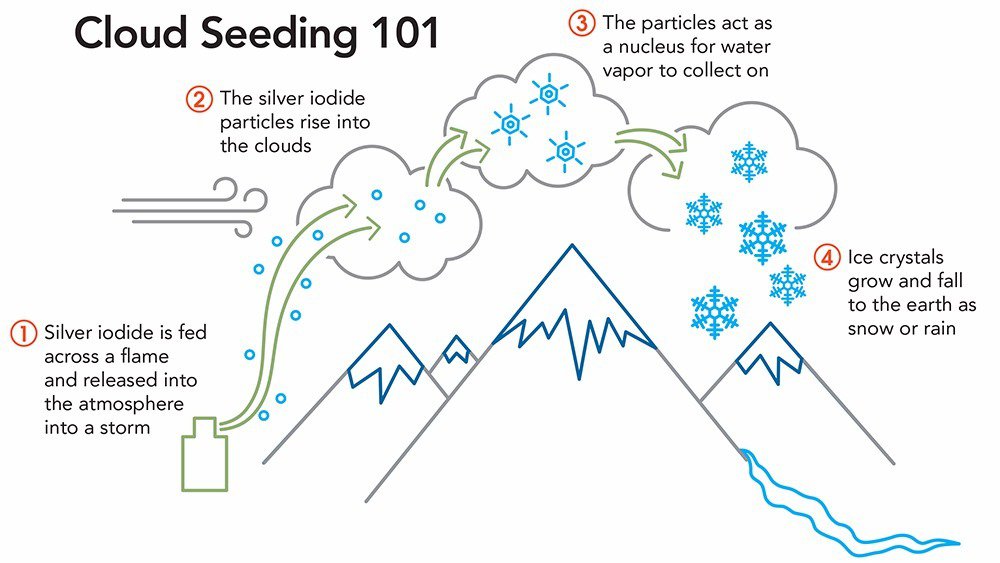THE GOVERNMENT IS USING CHEMICALS TO CONTROL OUR MINDS & THE WEATHER.
One of these we know as fact and it's formally known as cloud seeding: a process of injecting silver iodide particles into clouds from planes. Used around the world for various applications such as mitigating hail storm damage in Alberta, Canada to decrease the intensity of the storm which would have caused an estimated "C$100million in damage to homes and cars." according to Terry Krauss, a meteorologist at Alberta Severe Weather Management Society. (Pelley)
While no concrete statistics from the past 70 years suggest that cloud seeding is proven to work, efforts continue to integrate the practice where applicable; including ski resorts such as Vail. The process is rather interesting but if you don't give a flying fuck about how cloud seeding started & the chemistry behind it, skip the next paragraph.
The process of cloud seeding dates back to 1946 "when Irving Langmuir and his colleagues, Vincent Schaefer and Bernard Vonnegut, discovered that silver iodide could transform supercooled water vapor into ice crystals at temperatures of –10 to –5 °C. In nature, clouds form when supercooled water vapor condenses and then freezes onto particles, called ice nuclei, made of dust and even bacteria. Droplets of pure water can’t form an ice crystal nucleus until the temperature drops to –40 °C. Yet if clouds contain aerosol particles, water molecules can use the solid surfaces of these “seeds” to organize themselves into a crystalline form at much warmer temperatures, from –20 to –5 °C.
Reasoning that precipitation must be limited by the scarcity of natural ice nuclei in the air, Schaefer and Vonnegut began atmospheric trials to inject artificial nuclei into clouds, and an industry was born. The researchers suggested that silver iodide was a good nucleating agent because its hexagonal crystalline lattice is nearly identical to the lattice that water molecules form in ice and snowflakes—one in which units of six water molecules assemble. Silver iodide is the seeding agent of choice for cold clouds, although firms also deploy potassium chloride and dry ice, says Bruce Boe, vice president of meteorology at Weather Modification Inc." (Pelley)

Layman's Terms
So how does cloud seeding affect skiing? One example is from the resort everyone loves to hate, Vail. For the past 40 years, Vail Resorts have employed cloud seeding tactics to increase snowfall. The effectiveness varies greatly, even when done correctly: averaging around 10% increase of precipitation, all the way up to 25%, and some treatments 0%.
The cost per winter is only $250,000 which, for Vail, is about equal to 10 lift tickets. Joking. Sort of.
Now, I know what you're thinking; a 1 inch increase per storm is barely noticeable, so why do it? At the end of the year after dozens of cloud seeding treatments that could equate to several additional feet which provides a more solid base, extends the season out further, in turn making Vail more money, ect. The real question is though; what are the effects on the environment/humans/critters that live on the mountain?
According to geochemist Shawn Benner from Boise State University, "The near impossibility of detecting a silver iodide signal in snowpack after seeding attests to its low environmental risk." Naturally occuring silver iodide in snowfall typically measures out to about 1-2 ppt (parts per trillion). After a cloud seeding, levels of silver iodide range from 4 to 20 ppt. In large doses, silver iodide is toxic to aquatic animals but to get to that level, the readings would have to increase by 250,000% (50,000 ppt). At the moment these readings are encouraging but if cloud seeding continues on a mass scale, silver iodide levels could increase at an alarming rate.
In the end, cloud seeding is "still more of an art than a science," according to Stanford Univeristy ecologist, Rob Jackson. More research is needed to better understand whether cloud seeding is truly effective and what the natural, social, and governmental influence will have in the long run.
What do you think? Is cloud seeding something we should continue to do, not just for skiing but for all applications, or is the unknown and potentially dangerous fallout of this process too risky?
Source: Pelley, Janet. “Does Cloud Seeding Really Work?” CEN RSS, C&EN, 30 May 2016, cen.acs.org/articles/94/i22/Does-cloud-seeding-really-work.html.


Comments